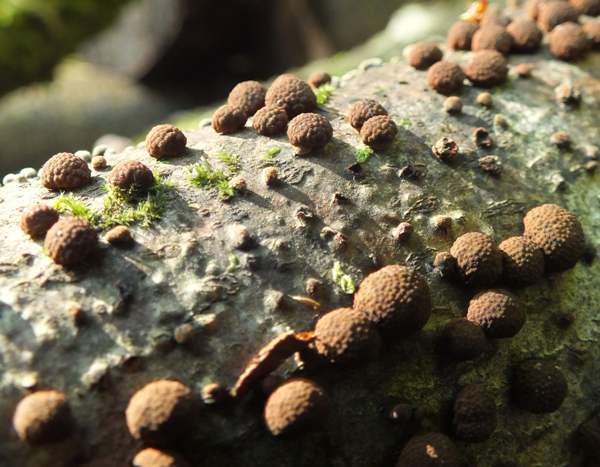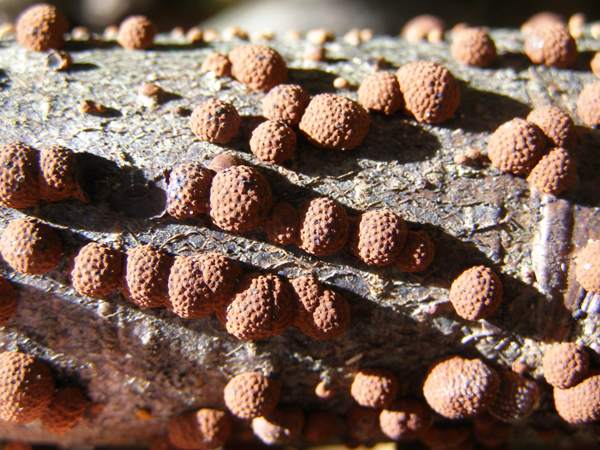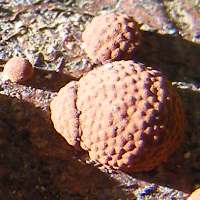Trees Birds Mammals Fish Amphibians Reptiles
Wild Algarve
Bookshop
Hypoxylon fragiforme (Pers.) J. Kickx f. - Beech Woodwart
Phylum: Ascomycota - Class: Sordariomycetes - Order: Xylariales - Family: Xylariaceae
Distribution - Taxonomic History - Etymology - Identification - Reference Sources

Hypoxylon fragiforme, commonly called the Beech Woodwart, appears throughout the year but is particularly noticeable during late autumn and winter. This ubiquitous little rotter is one of the pyromycetes or flask fungi.
Distribution
A very common species in Britain and Ireland, Hypoxylon fragiforme is found also throughout mainland Europe and in many parts of North America.

Taxonomic history
The scientific name Sphaeria fragiformis was given to this ascomycetous fungus in 1794 by Christiaan Hendrick Persoon, but its currently accepted name Hypoxylon fragiforme dates from 1835, when Flemish botanist Jean Jacques Kickx (1842 - 1887) transferred Beech Woodwart to the genus Hypoxylon.
The many synonyms of Hypoxylon fragiforme include Sphaeria fragiformis Pers., Hypoxylon cupreum Fr., Hypoxylon coccineum Bull., and Sphaeria lateritia DC.
Etymology
The genus name hypoxylon comes from hypo- meaning beneath (or less than) and -xylon meaning wood. The specific epithet fragiforme comes from the Latin name for a strawberry, fragaria, and refers to the strawberry-like shape and pimply surface texture of the stromata.
Identification guide
 |
Description
Stroma (plural stromata) - the name given to the communal fruitbody of an ascomycete fungi - hemispherical to nearly globose, 2 to 9mm in diameter and 2-7mm in height; initially greyish-white, becoming salmon pink and then rusty brown to mid brown at maturity before blackening when old; the surface is minutely bumpy (pimple-dotted) at maturity. The bumps are the openings of the ascospore-forming perithecia embedded in the surface. The infertile interior flesh is hard and black. |
| |
Spores
Elongated ellipsoidal or allantoid (bean shaped), smooth, 10-15 x 4.8-6.8µm.
Spore print
Very dark brown.
Asci
Typically 135-180 x 7-10µm, with eight spores per ascus; tips amyloid. |
Odour/taste |
Not distinctive. |
Habitat & Ecological role |
Saprobic, on fallen branches and rotting stumps of
broad-leaf trees, mainly Beeches. |
Season |
Throughout the year, but producing ascospores in autumn and early winter. |
Similar species |
Hypoxylon howeianum is similar but has smaller ascospores (7-9 x 3.5-5µm). |
Reference Sources
Fascinated by Fungi, 2nd Edition, Pat O'Reilly 2016, reprinted by Coch-y-bonddu Books in 2022.
Dennis, R.W.G. (1981). British Ascomycetes; Lubrecht & Cramer; ISBN: 3768205525.
Breitenbach, J. & Kränzlin, F. (1984). Fungi of Switzerland. Volume 1: Ascomycetes. Verlag Mykologia: Luzern, Switzerland.
Medardi, G. (2006). Ascomiceti d'Italia. Centro Studi Micologici: Trento.
Dictionary of the Fungi; Paul M. Kirk, Paul F. Cannon, David W. Minter and J. A. Stalpers; CABI, 2008.
Top of page...
Fascinated by Fungi. Back by popular demand, Pat O'Reilly's best-selling 450-page hardback book is available now. The latest second edition was republished with a sparkling new cover design in September 2022 by Coch-y-Bonddu Books. Full details and copies are available from the publisher's online bookshop...